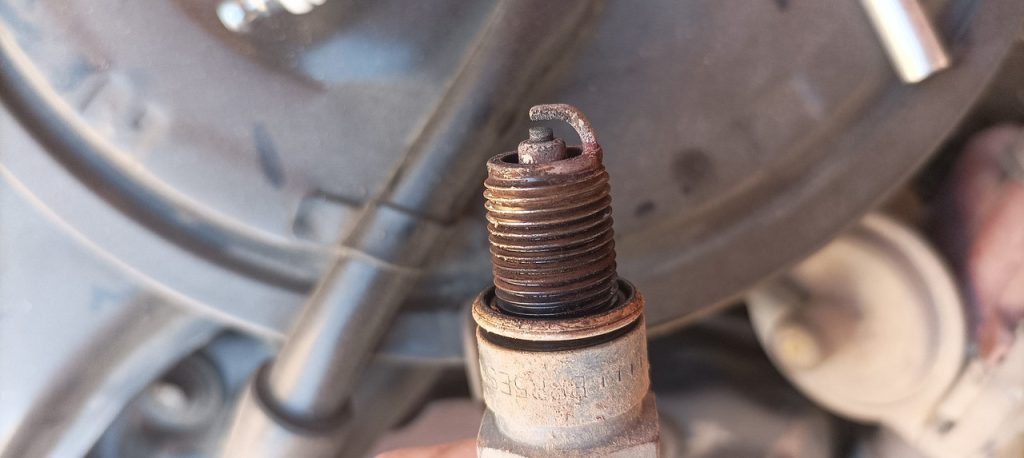Spark plugs play an important role in the combustion engine. However, one common misconception is the tendency to judge a spark plug’s condition based solely on its outward appearance. Many vehicle owners and even some mechanics mistakenly assume that if a spark plug looks good on the surface, it must be in working order.
In this article, we will therefore take a closer look at – and answer, the question: “Can a Spark Plug Look Good and Still be Bad?”. We will discuss how you can identify spark plug health and the factors that go beyond their superficial appearance.
The Role of Spark Plugs in Engine Performance
The primary job of spark plugs is to create a spark that ignites the air-fuel mixture within the engine’s cylinders. This ignition process is key for the proper functioning of the engine.
When you turn the key or press the ignition button, fuel is injected into the engine’s cylinders, and air rushes in to create a mixture. When the spark plug fires, it generates a spark that ignites the compressed air-fuel mixture. This controlled explosion creates the force needed to move the pistons, getting your engine going.
Moreover, spark plugs also play a vital role in engine efficiency, emissions control, and overall performance. A well-maintained set of spark plugs ensures that the combustion process is efficient and reduces fuel consumption. Spark plugs contribute to both the longevity of your engine and the preservation of our environment.
Judging Spark Plug Health by Appearance
A common pitfall amongst many vehicle owners and even seasoned mechanics fall into is the assumption that a spark plug’s outward appearance tells the whole story about its health.
Visual inspection is often the first step when it comes to assessing the condition of spark plugs. However, that is just the very first step in a proper assessment. You pull out the spark plug and form an initial judgment based on what you see. But the fact is that a spark plug can appear perfectly fine on the surface while hiding potential issues beneath that polished exterior.
One misleading factor is the presence of carbon deposits and fouling. These are normal byproducts of the combustion process and can accumulate on the spark plug’s electrodes over time. These deposits make a spark plug look dirty or worn but don’t necessarily indicate a failing spark plug. On the contrary, they can often be cleaned, restoring the spark plug to proper function.
Moreover, a spark plug with clean, shiny electrodes might give off the impression of being in excellent condition. However, this is not always the case. The internal components and functioning of the spark plug are what truly matter, and these factors are invisible to the naked eye.
Factors Beyond Appearance
As we have established, a spark plug’s exterior appearance can be misleading when it comes to giving information about its condition. To truly understand the condition of these essential engine components, we need to look at the factors that extend beyond mere aesthetics.
Internal Condition of the Spark Plug
Inside the spark plugs, there are a lot of things that require inspection. Here are some key factors that determine its overall health:
- Insulation Resistance: One critical aspect often overlooked during a visual examination is the insulation resistance. This refers to the spark plug’s ability to prevent electrical leakage along its ceramic insulator. If this resistance is compromised, it can lead to erratic sparks and misfires. This is true even if the plug looks pristine on the outside.
- Electrode Gap: The gap between the spark plug’s central electrode and ground electrode is an important parameter. This gap directly affects the spark’s intensity and effectiveness. Over time due to wear or erosion, this gap can widen. This leads to weaker sparks and poor combustion.
- Erosion and Wear: Continuous exposure to high temperatures and electrical discharges can wear out the spark plug’s electrodes. Erosion and wear can lead to reduced performance and misfiring, even if the exterior of the spark plug appears to be in good condition.
Electronic Testing Methods for Spark Plug Health
A visual inspection is a useful starting point but electronic testing methods provide a more comprehensive evaluation of a spark plug’s condition. These methods can reveal issues that might go unnoticed during a surface examination. Here are a couple of common electronic tests:
- Ignition Coil and Secondary Ignition Voltage Testing: By measuring the voltage generated by the ignition coil and observing the secondary ignition patterns, mechanics can diagnose spark plug issues accurately. This testing method provides insights into the spark plug’s ability to generate a strong spark under load.
- Resistance Measurements: Measuring the resistance of the spark plug’s internal components, including the ceramic insulator and electrodes, can pinpoint problems related to insulation breakdown or wear.
Signs of a Bad Spark Plug
Now, it’s time to look at what happens when spark plugs start misbehaving. A spark plug’s condition can manifest in a variety of ways that impact your vehicle’s performance. Here are the telltale signs that might indicate a spark plug is not in the best condition.
Symptoms of Spark Plug Issues
- Rough Idling: One of the earliest signs of spark plug trouble is a noticeable change in your engine’s idle behavior. If your car starts to shake or produce irregular revving when idling, it could be due to a misfiring spark plug.
- Reduced Power and Acceleration: A vehicle with failing spark plugs often has reduced power and sluggish acceleration. You may find it harder to reach highway speeds or experience a noticeable drop in overall performance.
- Poor Fuel Economy: Faulty spark plugs can lead to inefficient combustion which causes your engine to consume more fuel than necessary. If you notice that your car suddenly has a reduced fuel efficiency, it is a good idea to take a closer look at the spark plugs.
- Engine Misfires: Misfires occur when a spark plug fails to ignite the air-fuel mixture in a cylinder. This can result in a sudden loss of power and jerking sensations while driving. It may even cause a flashing check engine light.
The Relationship Between Symptoms and Spark Plug Condition
It is important to know the connection between the discussed symptoms and the spark plug condition in order to resolve any issues in a timely manner. When a spark plug is in poor health, it won’t perform the important task of igniting the air-fuel mixture effectively. This leads to incomplete combustion, which in turn causes the aforementioned issues.
Maintenance and Replacement
Lastly, it’s time to look at the proactive steps you can take now that we have discussed the signs of spark plug issues. Proper maintenance ensures that your spark plugs continue to perform optimally. They also contribute to a smooth and efficient engine operation.
Like with all car parts, regular maintenance is key. This will ensure the longevity and proper functioning of your car and engine.
- Efficiency and Performance: Well-maintained spark plugs help ensure efficient combustion. This leads to better fuel economy and enhanced engine power. You’ll also get a smoother and more responsive driving experience.
- Emissions Control: Properly functioning spark plugs help minimize harmful emissions.
- Engine Longevity: When your spark plugs are in good condition, they reduce the strain on other engine components. This extends the overall lifespan of your engine.
Guidelines for Spark Plug Replacement Intervals
Spark plugs are built to withstand a lot of wear and tear but they will wear out over time. The constant exposure to high temperatures and electrical discharges takes its toll. For this reason, it’s important to follow recommended replacement intervals. Here’s a general guideline:
- Copper Spark Plugs: These are typically the most affordable but have a shorter lifespan, typically around 20,000 to 30,000 miles.
- Iridium and Platinum Spark Plugs: These premium options can last significantly longer, often up to 60,000 to 100,000 miles or more. However, it’s crucial to consult your vehicle’s manual for manufacturer-specific recommendations.
- High-Performance and Modified Engines: If you have a high-performance or modified engine, spark plug replacement intervals may differ. Always follow the recommendations provided by the manufacturer or a qualified mechanic.
In addition to regular replacement, you also want to consider factors like your driving habits and environmental conditions. Frequent stop-and-go driving such as in cities, or exposure to extreme temperatures may lead to the the need for more frequent spark plug changes.
Lastly, selecting the appropriate spark plugs for your engine is another important aspect of maintenance. Spark plugs come in various types and are each designed for specific engine configurations and performance needs. It’s best to read your vehicle’s manual or talk to a qualified mechanic to ensure you choose the right spark plugs for your vehicle.


